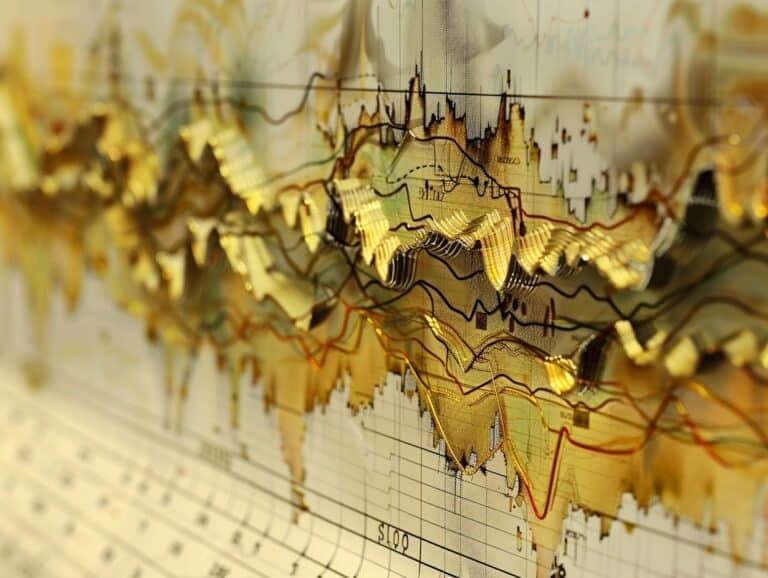Gold prices demonstrate remarkable resilience as markets anticipate potential rate cuts from the U.S. Federal Reserve, while lower Treasury yields further bolster its appeal among investors.
Short Summary:
- Gold remains a crucial hedge against the backdrop of expected interest rate cuts by the Federal Reserve.
- Geopolitical tensions and an increase in central bank demand continue to support gold prices.
- Market analysts anticipate bullish trends for gold as economic data points toward stabilized inflation.
In recent trading sessions, gold prices have shown steadfastness, reaffirming their significance as a safe haven amidst evolving economic landscapes. As of Thursday, gold was quoted at approximately $2,453.23 per ounce, slightly below Wednesday’s peak of $2,483.60, which marked an all-time high for the precious metal. According to
Russell Shor, a senior market specialist at Tradu, “Analysts foresee long-term gains for the precious metal, driven by the Federal Reserve’s preparations to cut rates, believing inflation is under control.”
The anticipation surrounding a rate cut in September has gained traction, with analysts indicating a 100% probability of such a move, as projected by the CME FedWatch Tool. The non-yielding nature of gold makes it more attractive in environments with lower interest rates, consequently enhancing its investment allure.
The recent employment report highlighted a rise in applications for unemployment benefits, suggesting a level of economic uncertainty. Yet, despite these mixed signals, the labor market remains relatively stable, with observations pointing toward a sustained demand for gold as a hedge. Meanwhile, the
International Monetary Fund has advised the Fed against cutting interest rates until late 2024
, presenting a conflict in perspectives regarding monetary policy. The European Central Bank, on the other hand, opted to maintain its current interest rates, leaving future decisions open-ended according to President Christine Lagarde, who stated that a move in September was “wide open.”
Geopolitical dynamics, particularly stemming from strained U.S.-China relations, have also sparked an increase in safe-haven demand for gold. Jim Wyckoff, a senior market analyst at Kitco Metals, noted that “some safe-haven demand is being triggered from China due to the negative rhetoric coming from both U.S. presidential candidates towards China.”
The insights from the
World Gold Council
reveal a positive trend in global physically backed gold exchange-traded funds (ETFs), showing heightened interest in gold as an investment vehicle. Following a robust contribution from central banks alongside geopolitical uncertainty, gold has rallied significantly over recent months.
As the week unfolded, gold prices demonstrated volatility, with spot gold prices fluctuating and reflecting the broader market sentiment. On Friday, the metal recorded minor changes, settling at around $2,427.73 per ounce, following a substantial 1.9% gain on Thursday. However, this weekly performance reflects a 0.6% decline in prices, a disparity fueled largely by a broader sell-off in equities that saw investors liquidating positions.
Market analysts like
Zain Vawda from MarketPulse by OANDA
remain optimistic about gold’s prospects, stating, “In the medium term, the outlook for gold remains positive, with any dips likely to be short-lived due to underlying macroeconomic factors.” The release of upcoming critical economic data, particularly the U.S. Consumer Price Index (CPI), is anticipated to further influence Federal Reserve policymakers’ decisions and may instigate fluctuations in gold prices.
Despite pressure from a slight uptick in the U.S. dollar and treasury yields hovering around recent highs, the long-term outlook for gold continues to trend positively.
Ole Hansen, head of commodity strategy at Saxo Bank, emphasized the role of gold as a “diversifier hedge against turmoil elsewhere,”
illustrating its inherent value amidst market volatility.
The landscape for precious metals extends beyond gold alone. Spot silver saw a slight decline, dipping to $29.93 per ounce, while both platinum and palladium faced downward pressure, reflecting a broader trend across commodities. Nevertheless, demand for gold remains unaffected by these shifts, benefiting from both central bank buying and escalating global tensions.
In summary, while gold prices have faced headwinds recently, several factors—ranging from speculated interest rate cuts and geopolitical instability to a steady demand from investors—position it favorably for continued growth. As further data emerges, traders are expected to navigate this complex environment keenly, maintaining a close watch on inflation trends and Federal Reserve communications to calibrate their strategies effectively.
What Lies Ahead for Gold Prices?
Looking into the near future, the trajectory for gold appears heavily influenced by both macroeconomic indicators and geopolitical developments. Analysts agree that while monetary policies will be pivotal, persistent demand from major economies, coupled with rising inflation expectations, will significantly contribute to gold’s performance. In light of rising central bank reserves worldwide and the ongoing divestment from traditional fiat currencies, gold’s status as a valuable asset remains unchallenged.
As
Nigel Green, CEO of deVere Group, pointed out, “We see the momentum for gold to continue for the foreseeable future, as investors are reminded of its enduring appeal as a safe haven asset.”
This sentiment underscores the persistent importance of gold in investment portfolios, particularly as U.S. economic rivals explore alternatives to dollar-based reserves.
A Comprehensive View on Market Dynamics
Though the market is currently witnessing fluctuations, multiple analysts view gold’s potential as a hedge against economic turbulence as paramount. With the potential for an economic pivot in monetary policy based on upcoming employment and inflation data, traders are gearing up to respond proactively to evolving market conditions.
In conclusion, gold prices are not only resilient amid current fluctuations but are also well-positioned to exploit new economic opportunities as they arise, making the precious metal a focal point for investors keen on stability in an unpredictable financial landscape.
Authors & Disclosures
- Our content is independently written and reviewed by trusted reviewers & fact-checkers.
- We can earn money by connecting you with top Gold IRA Companies. Learn how our reviews work.
- Want to learn more? Meet our authors and explore our editorial policy.






